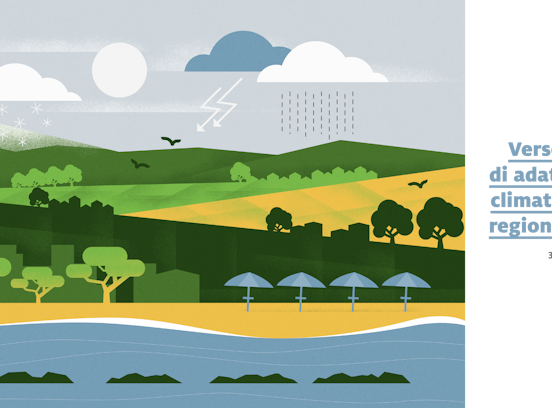RegioneMarche
Definition of the Climate Adaptation Plan for Marche region
- Deutsch
- English
- Italiano
- Project duration: -
- Project status: finished
- Funding: Private organisations (Other projects /Project)
- Institute: Center for Climate Change and Transformation
The project aims to build the methodological bases, skills and knowledge useful to the
the Marche region for the definition of the regional adaptation plan, and to improve the adaptive capacity of the regional
adaptive capacity of the regional structure in order to make it able to monitor, review and update the adaptation plan and to increase territorial resilience.
update the adaptation plan and increase territorial resilience.
The rationale behind this project is based on horizontal and vertical mainstreaming, through the
involvement of public and private stakeholders. This mainstreaming will be achieved by involving the
regional coordination structure, in which are present the different regional offices that have been
sustainable development strategy, any other regional offices that are considered relevant to adaptation policies and the
for adaptation policies as well as the municipal and provincial level. In addition, it is considered
In addition, it is considered essential to involve also the political side, as a central element to assess the feasibility
of adaptation policies. Through this approach becomes possible to build a plan
coherent with the territorial needs and therefore more accepted for its implementation and
implementation. This approach qualifies the adaptation process as a process that informs and guides sectoral planning and programming.
guides the regional sectoral and territorial planning and programming, even where, possible
in the methods and procedures, as defined by the guidelines for adaptation planning at the
regional level (see MASTER ADAPT project).
In this way it will be possible to highlight not only the risks, but also the opportunities that may arise from climate change.
The project will provide for:
1) the necessary convergence and coherence of disaster risk reduction (DRR) policies with those of
climate change adaptation (CCA), in the context of sustainable development policies.
Through the analysis conducted we want to emphasize the elements that can qualify
the actions of adaptation to climate change also in terms of their effects on the reduction of the
disaster risks, promoting coherence between the two policies. This analysis is consistent with what
defined by the new European climate change adaptation strategy and the Fifth Report
Assessment (AR5) of 2014 of the IPCC in which the components of risk from climate change
climate are described as the drivers of disaster risk (United Nations Office for Disaster Risk
Reduction, 2017). The complementary approach between CCA and DRR, in addition to fostering enhanced resilience, addresses the need to identify actions and measures even under conditions of uncertainty, favoring the involvement of multiple stakeholders, i.e. going to strengthen a cross-cutting approach and systemic approach.
2) the semi-qualitative analysis of the assessment of the components of risk resulting from adaptation
to climate change. In particular, this approach will be followed in the definition of the chains of impact in order to understand in detail the risk of adaptation to climate change.
This approach will be followed in the definition of impact chains in order to understand in detail the climate risk and its different components, and to have useful information also from a more detailed point of view.
Contact person: Massimliano Pittore (massimiliano.pittore@eurac)
